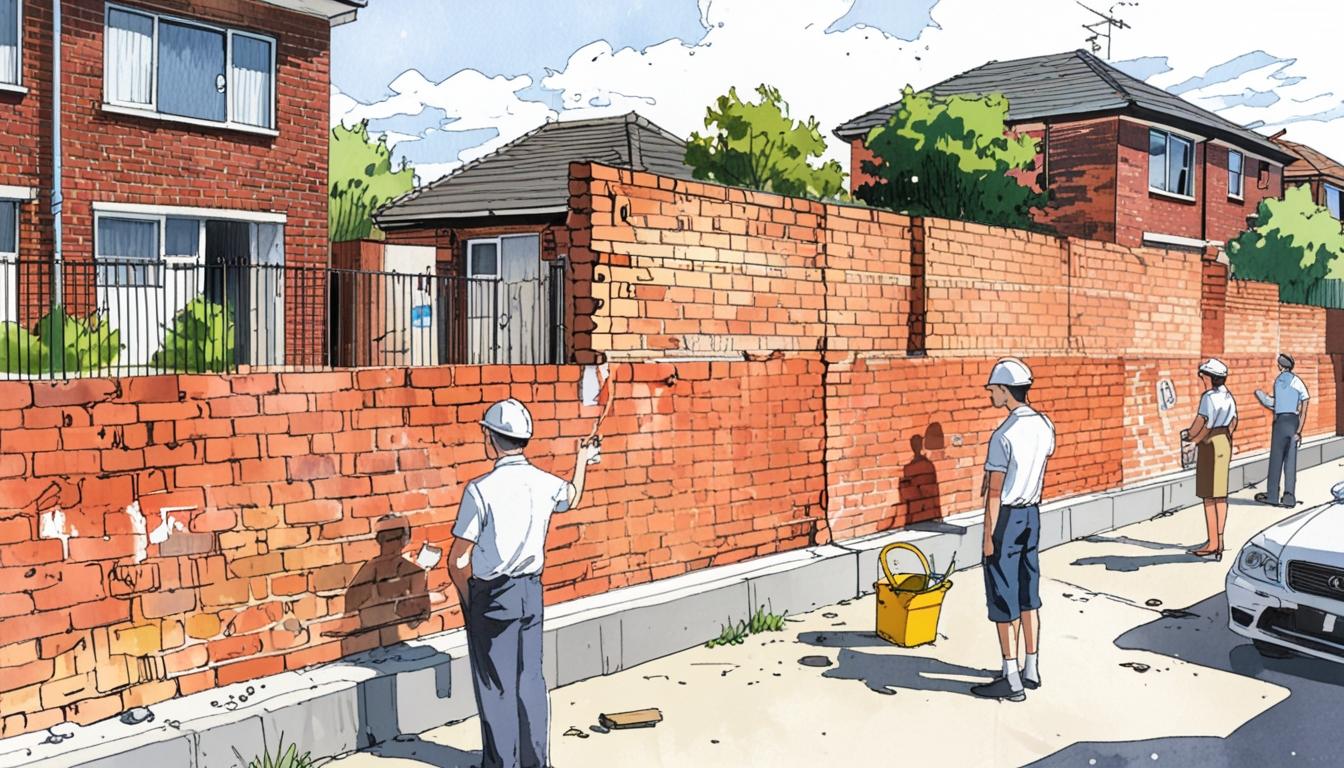A local resident challenges a developer over the ownership of a wall critical for emergency access to a new housing estate, amid claims of aggressive tactics and unclear property rights.
A dispute has arisen in Hempsted, Gloucester, between local resident Roger White and Lioncourt Homes, the developer behind a new housing estate comprising 70 homes. At the centre of the contention is a two-brick high wall, described as a “dwarf wall,” which Mr White claims is his property. The developer asserts that the removal of this wall is necessary to establish an emergency access route, a requirement specified in their planning permission.
Mr White, a 58-year-old IT worker, inherited the land on which the wall stands from his father following his death in 1997. He reflects on his father’s words, stating, “My father always said to me ‘keep an eye on it’.” He had been monitoring the site over the years and recently noticed substantial construction activity, including the erection of a concrete fence that indicated a development project was underway.
Upon further investigation, Mr White discovered that Lioncourt Homes intended to create an emergency access route due to concerns about potential flooding at the lane entrance. This route crosses his land and the wall in question. Following his discovery, he reached out to the developers to assert his ownership of the wall, and they confirmed, in writing, that it belonged to him. However, the company maintains that the wall is either part of the adopted highway or their own property.
According to GloucestershireLive, Mr White stated, “I contacted Lioncourt Homes and said ‘you don’t realise I own this’.” He expressed his frustration over what he perceives as aggressive tactics from the developers who issued a cease-and-desist letter to him arguing he has “no entitlement to a ransom” over the wall. Mr White’s solicitors have counter-argued, stating it is Lioncourt’s responsibility to prove that the wall falls within its property boundaries.
Lioncourt Homes has claimed possession of the wall based on documents from 1964, while Mr White is confident in his own documentation from 1971 showing his ownership. He emphasised the unusual nature of the situation, questioning how construction could proceed without proper consideration of property rights. “It is the most peculiar situation. I don’t understand how we can get to the point of 70 houses being built and nobody has actually looked into this before,” he stated.
While Mr White has expressed that he is not opposed to the development, he insists that the developers need to ensure that all procedures are followed correctly. He fears that their desire to move forward might result in the “bulldozing” of his wall, disregarding his rights. He remarked, “If they need to demolish the wall they need to buy the wall.”
In response to the situation, a spokesperson for Lioncourt Homes stated, “Works required to implement our planning permission is in land wholly owned by Lioncourt Homes or is in adopted highway land; no third-party land is required.” Meanwhile, a representative from Gloucestershire County Council commented on the matter, asserting that the legal boundary of Lioncourt’s land directly adjoins the public road of Honeythorn Close. They clarified that legal boundaries do not have physical width, and the status of the highway prevails over any private ownership claims below it, allowing the emergency access works to proceed lawfully.
The outcome of this dispute remains to be seen as both parties prepare for potential further action regarding the ownership of the wall and the progress of the housing development.
Source: Noah Wire Services
- https://www.scottishconstructionnow.com/articles/and-finally-wall-and-order – This article explains the dispute between Roger White and Lioncourt Homes over a two-brick high wall, with Lioncourt Homes claiming the wall is on their property or part of a public highway, while Mr White asserts it belongs to him. It also mentions Lioncourt’s issuance of a cease-and-desist letter to Mr White.
- https://www.punchline-gloucester.com/articles/aanews/gloucester-dwarf-wall-holds-up-multi-million-pound-development – This article provides details about Mr White’s perspective, including how he inherited the land and his belief that Lioncourt Homes should have approached him to purchase the strip before commencing construction. It also mentions the historical context and Mr White’s other land holdings.
- https://gloucestershiredaily.co.uk/dispute-over-ownership-of-dwarf-wall-in-new-housing-development/ – This source corroborates the heated nature of the dispute over the ownership of the dwarf wall, with a focus on the legal and procedural aspects of the conflict.
Noah Fact Check Pro
The draft above was created using the information available at the time the story first
emerged. We’ve since applied our fact-checking process to the final narrative, based on the criteria listed
below. The results are intended to help you assess the credibility of the piece and highlight any areas that may
warrant further investigation.
Freshness check
Score:
9
Notes:
The dispute appears to be current as there is no indication of outdated information. The narrative involves ongoing construction activities and recent communications between parties.
Quotes check
Score:
8
Notes:
Direct quotes from Roger White and Lioncourt Homes are provided. However, it’s unclear if these are the earliest or original sources of these quotes without further research.
Source reliability
Score:
8
Notes:
The narrative originates from SomersetLive, a known local news outlet. However, without further context about its overall reputation, it is considered generally reliable for local news.
Plausability check
Score:
9
Notes:
The claims about a property dispute over a wall seem plausible, considering the context of land ownership and development projects. Legal complexities and conflicting statements are typical in such cases.
Overall assessment
Verdict (FAIL, OPEN, PASS): PASS
Confidence (LOW, MEDIUM, HIGH): HIGH
Summary:
The narrative appears to be current and involves plausible claims about a property dispute. While the source is generally reliable, further verification of quotes could provide additional confirmation. Overall, the information seems credible based on available facts.













